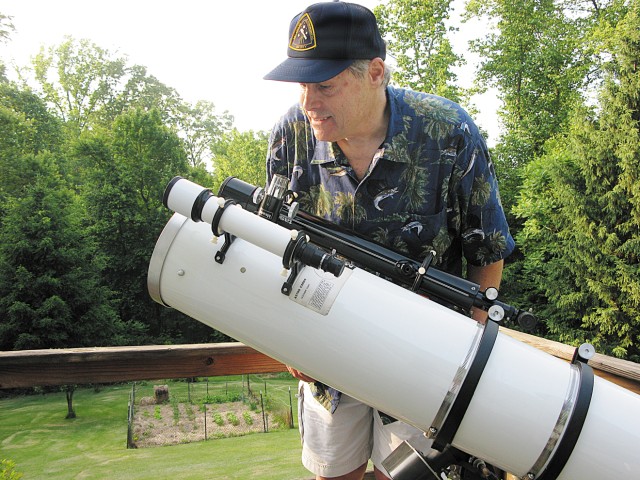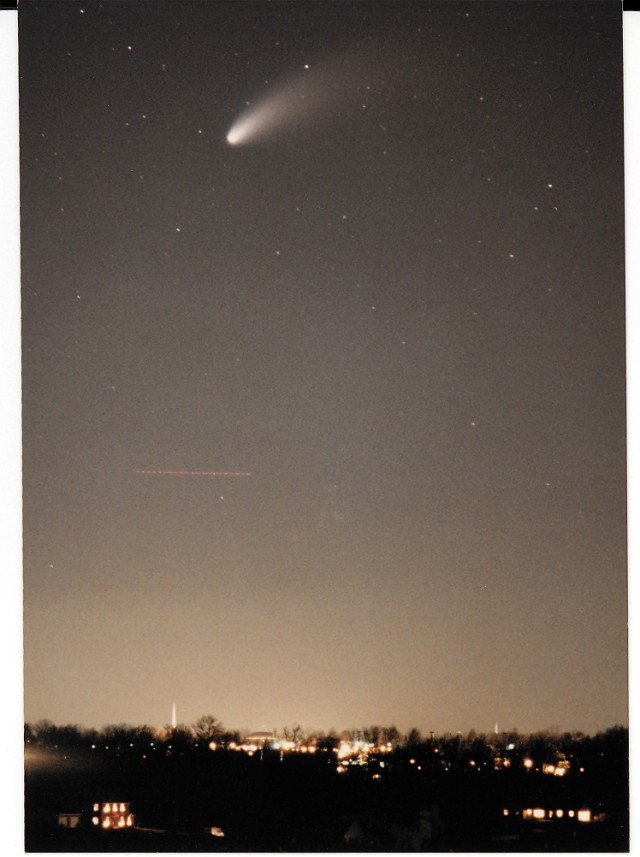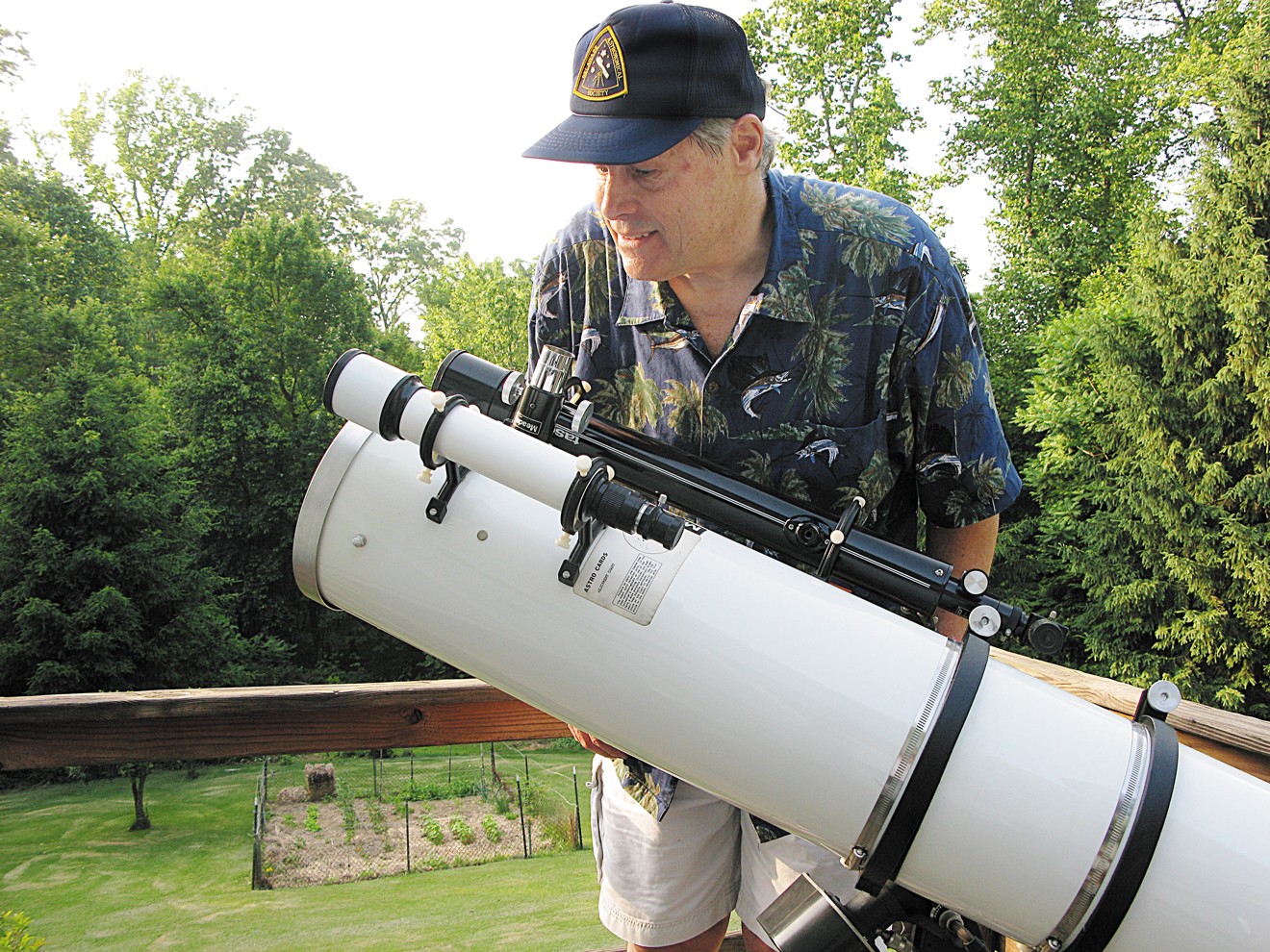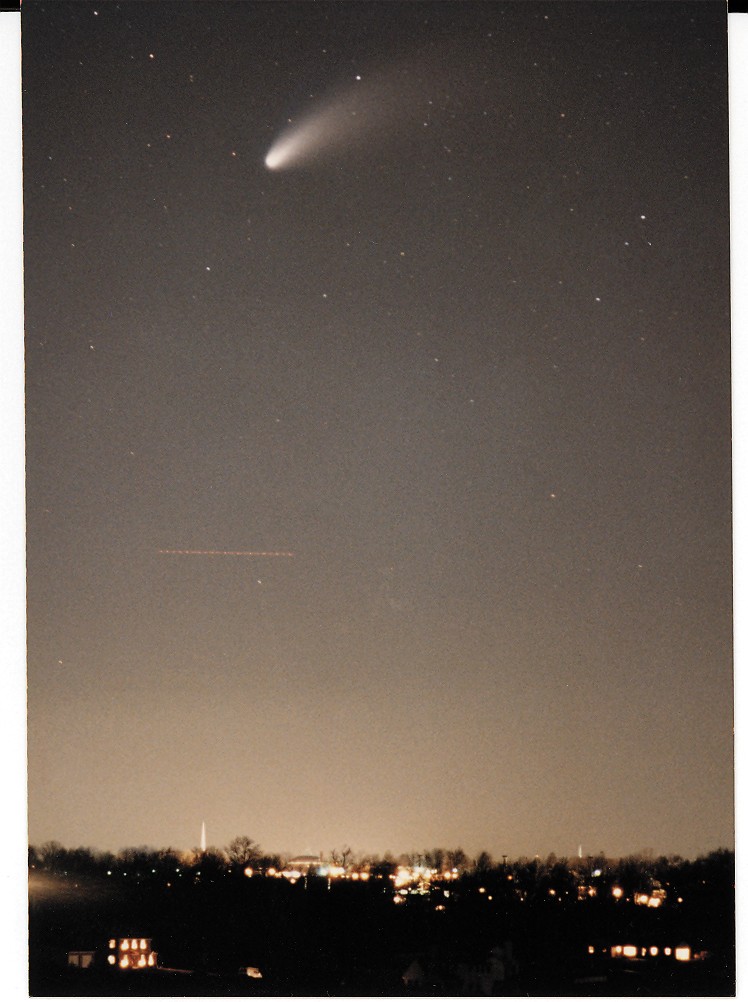When he gazes at the nighttime sky through one of several telescopes he owns, Tom DeMott sees a universe full of awesome spectacles and natural phenomena. DeMott, a visual information specialist for the U.S. Army Aberdeen Test Center, has been an avid amateur astronomer for many years. What began as a hobby when he explored the heavens with his father as a child has grown into much more than just a hobby since then.
DeMott said he and his father would view periodic comet visitations and meteor showers as they appeared in the night sky. What he saw sparked his imagination and aroused his curiosity, and astronomy became a lifetime interest.
On occasion he has been a teacher as well as an observer, helping others to understand astronomical phenomena during "star parties" he led as a member of the Delaware Astronomical Society.
DeMott's dedication to the science of astronomy earned him recognition in 1991 when the Delaware Astronomical Society selected him as the organization's "Astronomer of the Year." He was the organization's sky-show chairperson for seven years, which he believes earned him the honor. In that capacity, he prepared talks and helped to organize evening star-gazing events for educational purposes. While people peered into the night sky, he explained which planets were visible and where they were, and pointed out the major constellations. As a technical associate of the Mount Cuba Astronomical Observatory near Wilmington, Del., he worked with a team of members to plot the courses of periodic comets. He made necessary calculations with the aid of an ephemeris, which in astronomy is a table of values that gives the positions of astronomical objects in the sky at a given time or times.
"That, along with declination and right ascension - celestial map coordinates - provides the tracks of known periodic comets," he explained. "There are usually a number of technical-associate and amateur-astronomer volunteers involved in special interest groups at MCAO. Comet Astrometry is only one aspect of the research programs in progress at the observatory."
In addition to creating slide presentations and giving outdoor observation sessions, DeMott has been a classroom speaker and has told stories about star names, myths and legends at many Girl/Boy Scout camps, church organizations and elementary and secondary school programs.
"People with an interest in astronomy don't need to have sophisticated telescopes and gadgetry to pursue it. Amateur star gazers can see many objects in the night sky with a pair of good binoculars," DeMott said.
"Typically, what you want to strive for is the brightest image you can get with a magnification that doesn't make the image too fuzzy and shake all over the place," he explained. "Mounting any size binoculars on a tripod is an advisable solution to these problems. If you can't afford a tripod, the maximum balance is "7x50s" for hand-held binoculars. With those, you can explore the star clusters in the Milky Way, see the phases of Venus, the red color of Mars, the rings of Saturn, and sometimes the belts around Jupiter.
"The Orion Nebula is a large, gorgeous smudge in binoculars, as is the Andromeda Galaxy. All naked-eye comets, like the recent comets McNaught and Hale-Bopp, are absolutely brilliant in binoculars," he continued.
"For tripod-mounted binoculars, a pair of "11x70s" will show you all of those things, but brighter. These binoculars are very expensive, about three hundred dollars, and really can't be used for anything but looking at the sky. None of the really faint deep-sky objects, like the Crab Nebula, are visible with binoculars.
"Amateur astronomers have contributed to the science in many ways," DeMott said. "Some have even made significant discoveries. Armed with a twelve-inch telescope, a computer and a NASA e-mail alert, Berto Monard of South Africa became the first amateur astronomer to discover an afterglow of a gamma-ray burst, the most powerful explosion known in the universe. Hanny van Arkel, a teacher in the Netherlands, was poring over photos of galaxies on the Internet in August 2007 when she stumbled across a strange object in the night sky - a bright, gaseous mass with a gaping hole in its middle.
Her startling find - a mysterious and unique object some observers are calling a 'cosmic ghost' - caught the attention of the people who run the Hubble Space Telescope."
It is an astronomical convention to rate the brightness of a star's light by magnitude. A small magnitude number means a star is bright, whereas stars with higher magnitude numbers are dimmer. Some stars that are incredibly distant from Earth only reveal themselves because they are exceptionally bright. DeMott said the most amazing aspect of astronomy is the window it gives the observer on objects at huge distances from Earth and events that occurred in the distant past, long before humans existed.
"When I looked at a faint bluish object known as Quasar 3C 273 in the constellation Virgo with my eight-inch telescope, I viewed light that left that object some 2.6 billion light-years ago," DeMott said. "At such a distance, objects have their light dimmed by 38.9 magnitudes. In order for us to even see 3C 273 means that it must be incredibly bright. Latest estimates point to 3C 273 being as bright as two trillion of our suns. That would make it as bright as one hundred times the combined light of all the stars in our Milky Way Galaxy."
Not content to study the night sky with binoculars or simple department store telescopes, DeMott has acquired some sophisticated hardware. He owns four reflecting telescopes and two refractor models. Reflector telescopes are so named because they reflect light with a parabolic mirror, which has a curved shape, like a saucer. The light is reflected back up to a secondary mirror that bounces it out of the tube to the eyepiece, where the user looks. In refractor telescopes, light travels through a big lens at the end of the tube to a small lens or eyepiece on the other end. Both types of telescopes have strengths and weaknesses, DeMott observed.
"If your primary goal is to look at the moon, the planets and terrestrial objects, a small refractor works well," he explained. "But larger refracting telescopes have size and cost factors. It is very expensive to make large lenses, whereas it is much more cost effective to make very large mirrors for reflecting telescopes. So, if you want to get a lot of light-gathering power in the form of a bigger telescope to view deep-space objects, then a reflector is the best choice."
Even with the best equipment, it is sometimes difficult to observe astronomical bodies.
"Light pollution, especially around densely populated urban centers, has been a big problem for astronomers," DeMott said.
"Most of the light you see at night is wasted light shining up into the sky instead of where it belongs - down on the ground," he explained. "Remember, by controlling light pollution we save money, lots of money. We can do better, but it will take a commitment by many people to make a difference so that nearly everyone has a better view of the universe.
"In a nutshell, there are three basic problems with outdoor night lighting," he continued. "A majority of outdoor lights are simply too bright. A majority of outdoor lights are not properly shielded, and thus cause unwanted and unsafe and expensive light trespass and glare. There are simply too many unnecessary outdoor lights out there - a great many paid for by you, the taxpayer."
Astronomers around the world are celebrating 2009 as the International Year of Astronomy. This year was chosen because it is the 400th anniversary of Galileo's use of a telescope to study the skies. It is also the 400th anniversary of the publication of the treatise Astronomia Nova (New Astronomy) by Johannes Kepler, a German mathematician and astronomer who figured out that planets revolve around the sun in elliptical rather than circular orbits. A variety of public events are taking place, and more information about those occurring in the United States is available at http://astronomy2009.us.
Locally, the Mount Cuba Astronomical Observatory in Greenville, Dela., is hosting "Public Nights" which will continue year round. In addition to learning about many aspects of the heavens, participants will have a chance to visit and view the observatory's all-digital full-dome planetarium. A schedule is available at http://mountcuba.org.
Star parties will be held on the grounds of the observatory and at other locations. Participants can bring their own telescopes or observe the night sky through other people's equipment.
Telescopes in use may include a 12.5-inch Newtonian reflector, 17-inch Coulter Odyssey 2 or a 6-inch Orion SkyQuest XT6 Dobsonian if it is not on loan. Star parties are always contingent on the weather. For more information, call the MCAO at 302-654-6407. Interested parties can also obtain more information at these Web sites: www.harfordastro.org, www.physics.udel.edu/mcao, www.skyandtelescope.com/ and www.astronomy.com/asy/default.aspx.




Social Sharing